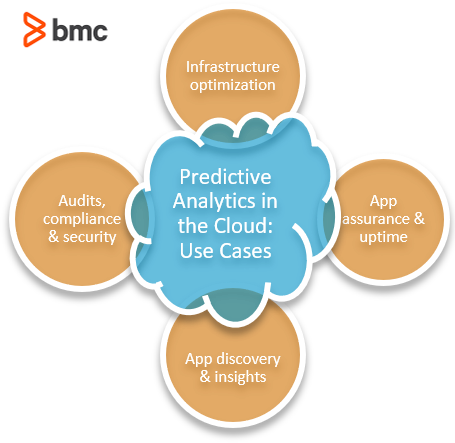Infrastructure operations in the era of complex multi-cloud technologies have emerged as challenging and resource-intensive tasks, especially for the average cloud computing customer who is merely seeking to optimize cloud investments and resource performance. After all, organizations upgrade their infrastructure to operate at scale while reducing expenses, performance, and security issues.
However the diagnostics, resolution, and optimization of the infrastructure is a challenge, considering the vast, dynamic, and interconnected nature of the underlying hardware resources. Predictive analytics aims to modernize and simplify the complexity of cloud infrastructure operations by leveraging the vast deluge of data associated with IT operations.
Let’s take a look.
What’s predictive analytics?
Predictive analytics is the practice of using data to determine future patterns and behavior of a system.
Predictive analytics tools, such as forecasting and predictive modeling, may use advanced machine learning algorithms and statistical analysis techniques to identify a system model with high accuracy. The prediction models applied to historical and present data can unveil insights into future trends of the system behavior. Using this information, decisions can be made regarding the system proactively:
- Predictive analytics can help identify correlations between behaviors that otherwise may be overlooked or perceived as isolated.
- Algorithmic filtering also reduces the noise data and false alarms that may keep IT Ops teams rifling through vast data to identify the most useful insights.
This capability offers immense opportunities in the IT infrastructure operations segment, where an isolated anomalous network traffic behavior can translate into a large-scale data leak and remain hidden until it’s too late to react. Predictive analytics constitute the building blocks of a modern AIOps architecture, which includes:
- Data ingestion
- Auto-discovery
- Correlation
- Visualization
- Automated actions
Predictive analytics in the cloud
For cloud operations in particular, predictive analytics has a key role to play in these use cases:

Cloud infrastructure optimization
Many organizations use multiple cloud environments and, possibly, a range of siloed infrastructure monitoring, management, and troubleshooting solutions. In order to gain visibility into the hybrid multi-cloud environment, Cloud Ops teams using traditional analytics practices may rely on manual capabilities and overlook the correlating information pieces across the infrastructure environment.
Data applications and IT workloads are increasingly dynamic in nature and the unpredictable changes in network traffic, infrastructure performance, and scalability requirements impact IT operations decisions in real-time. Making the right decisions proactively requires Cloud Ops to collect the necessary information from various sources and being able to correlate the information across the siloed IT environments.
Predictive analytics allows users to focus on the knowledge gleaned from data instead of collecting, processing, and analyzing information from multiple cloud environments independently. Regardless of the complexity of the cloud network, advanced machine learning algorithms that power predictive analytics capabilities provide the necessary abstraction between the complex underlying infrastructure and data analysis. Cloud Ops are ultimately able to use the collective insights to proactively make the right decisions regarding:
- Resource provisioning
- Storage capacity
- Server instance selection
- Load balancing
- Other key cloud operations decisions
Application assurance and uptime
Software applications are an integral component of business processes. When the apps and IT services go down, business processes risk interruption. For this reason, IT shops continuously monitor an array of application and IT network performance metrics that correlate with business process performance. Any anomaly identified in the IT performance impacts business operations.
With predictive analytics solutions in place, IT can proactively prepare for possible downtime or infrastructure performance issues. The organization can establish pre-defined policies and measures to apply corrective actions and policies automatically well before application assurance and uptime is potentially compromised. As a result, the organization doesn’t have to rely on IT in order to:
- Troubleshoot issues
- Improve Mean Time To Detect (MTTD) and Mean Time To Repair (MTTR) capabilities
Predictive analytics algorithms further cut through the noise to ensure that only the impactful metrics threshold cause the organization to adapt its business processes when needed.
Application discovery and insights
Enterprise networks are typically distributed across regions and contain diverse infrastructure components, often operating in disparate silos. A holistic knowledge of the infrastructure and application discovery requires organizations to understand how those components interact and relate with each other, especially since network performance issues can spread across dependencies that are otherwise hidden from view.
With predictive analytics solutions, organizations can:
- Collect data from across the network
- Analyze multiple data sources
- Understand how one infrastructure system can impact the other
In hybrid IT environments, application and infrastructure discovery is a greater challenge considering the limited visibility and control available to customers of cloud-based services. Any lack of automated correlation between network incidents can limit the ability of organizations to steer cloud operations in real-time while responding to potential application and infrastructure performance issues.
Audits, compliance & security
Strictly regulated industries are often required to comply with regulations related to:
- Application uptime
- Assurance
- MTTR
- End-user experience and satisfaction
- Other parameters
Compliance is complex when these organizations have limited visibility and control over their IT network. Performing the audit activities at scale may require organizations to invest greater resources on IT. The regular business may not justify the increased operational overhead and organizations may be forced to cut the corners in audit, compliance, and security of sensitive data, apps and IT network.
Organizations using advanced artificial intelligence technologies can automate these functions and glean insightful knowledge that can translate into regulatory compliance of hybrid cloud IT environments without breaking the bank.
Security is another key enabler of regulatory compliance and requires more than automation solutions to accurately identify the root-cause of network traffic anomalies. Security infringements in the form of data leak tend to remain under the radar until unauthorized data transfers or network behavior is identified. In that case, it may be too late for organizations to respond without incurring:
- Data loss
- Non-compliance
- The ability to operate in security sensitive industries such as healthcare, defense, and finance
In complex cloud infrastructure environments, the role of predictive analytics is to unify the knowledge from the diverse, disparate, and distributed networks and empower organizations to make better, faster well-informed decisions.
Additional resources
For related reading, explore these resources:







